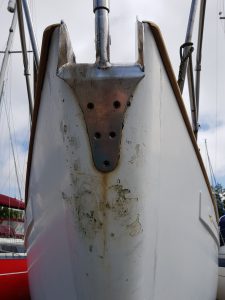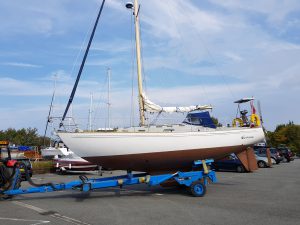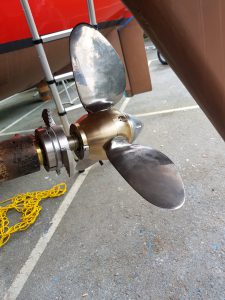It’s more than three months since I first saw Samsara. I went up North Wales on the train and, after checking into the cheapest B&B (the whole place smelled of stale milk) I walked down to the marina for a preview.
A preview is always a good idea. You don’t want the vendor to witness your first impression…
Actually, in this instance, it might not have been such a bad idea. The first impression was that this had been a wasted journey: While it is one thing for an old boat to show her age – you don’t want an antique to look as though it just came out factory – it is quite another when the words “shabby”, “a sorry state” and “sadly neglected” come to mind.
Wherever you looked there were scuffs and chips and poorly-filled holes. The scuppers were clogged with leaves and filth and there were things growing in the cockpit grating. One glance at the stem showed that the ancient 35lbs CQR had been taking bites out of it for years – to the point where the owner seemed to have given up worrying about it.


But I was looking for a boat to be my pride and joy – a joy for years to come. But I was not looking for “project”. All the same it was a long way to come and not see the whole boat – so the next morning found me returning at the appointed time to find the owner had clearly been there for some while attempting to put an encouraging gloss on things.
He needn’t have bothered because, as I mentioned in the last post, it was at this point that the boat took over. Little by little – without a lot of fuss or ostentation – she revealed herself to be just what I had been looking for all my life.
I won’t go into this now because I intend to have far too much fun writing at leisure about the way each little discoveries came to light. But let’s just say that 30 years ago when I sat drifting on my old Rival 32 Largo and made a list of all the improvements I would like to see, almost all of them had already been incorporated into Samsara. As for the scuffs and chips and holes… well, they were cosmetic. The main thing was that the boat was sound. Best of all, she was another Rival 32 – and surely I could find someone with an electric polisher…
In fact, I did better than that. I found a wonderful man called Barry Lovell and his little company TLC Boat Repair. It was the fact that the celebrated yachting writer Tom Cunliffe had trusted him with his Constance that decided me. After all Tom is a noted perfectionist.
But it wasn’t just that Barry and his team made such a wonderful job of the new locker lids in the cockpit or replacing the dreadful black rubber toe-rail with yards of teak or that they scrabbled around underneath scraping off years of antifouling – or even that he never charged for fixing the leak in the water tank. What made all the difference was that Barry knows everyone. Very early on in our friendship he made it very clear: “John,” he said. “Whatever you need, you come to me. I’ll look after you.”
For there was I, a stranger in town – 300 miles from home – knowing no-one and about to take a leap of faith with my pride and joy – and Barry put me on to all the right people.
There was Richie Williams in a workshop which looked as though it was waiting to be condemned who took the Aries self-steering piece by piece, understood instinctively how it worked – even though he had never seen one before – and put it back together again like a sewing machine.
There was Dave Worthington who worried away at the prop shaft so that I could have a feathering propeller which is as exciting as other men getting a Ferrari. There was Mike Kelly the stainless steel specialist who worked up until midnight because I forgot to tell him I wasn’t going in the water the next day after all.
Dave Evans with his brilliant idea for the new gas locker… Dave Jones who calmly accepted my electronic foibles like getting a regulator from Singapore instead of Milton Keynes.
Over three and a half months they came and they worked and they humoured me and if the launch date was put off and put off again until here we are going in the water in September, none of this matters if we get it right in the end.
And we have. In fact I have decided to add an extra page to the blog – a page of links to the people who have made it all possible.
It’s the least I can do.

The Old Man



I like the way you write. It flows nicely and I get to feel the essential feel of the sea. Thankyou.